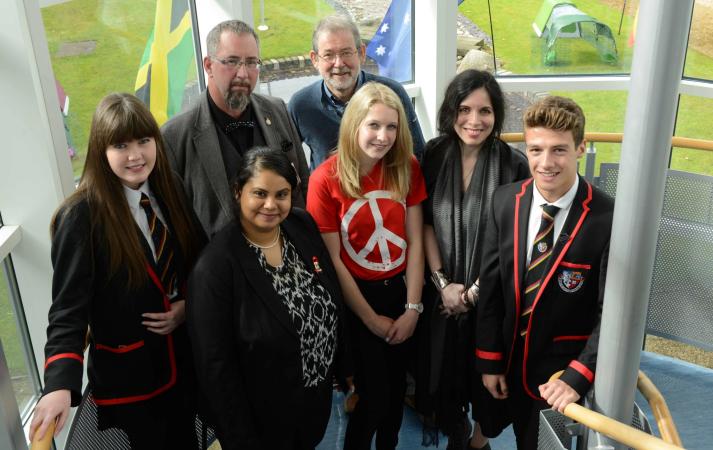On September 21, UN Peace Day was celebrated for the third time in Dunfermline, Scotland. The celebrations were initiated by Queen Anne High School who invited a total of 600 pupils from 11 different schools in the county of Fife to participate in a special Peace Day Conference.The event was supported by the Carnegie Dunfermline Trust who together with Queen Anne High School invited the Dutch Carnegie Foundation to give a speech on Andrew Carnegie, the ‘founding father’ of the Peace Palace and Dunfermline’s most famous son.
The idea behind the peace day celebrations at Queen Anne High School was to inspire both the pupils and the wider school community to become the driving force behind the vision of a united and sustainable world by learning about reconciliation, intercultural cooperation and global citizenship. The Dutch Carnegie Foundation was able to contribute to this idea by speaking to the pupils about Andrew Carnegie, his peace work and the important role he played in the history of the Peace Palace. Even though Andrew Carnegie was born and raised in Dunfermline and became known as the richest man of his day, little is known to the general public about his peace activities.
Our speaking engagement at Queen Anne High School was therefore a great opportunity for us to enlighten the pupils and engage a new audience in this important part of history. After Andrew Carnegie emigrated with his family from Dunfermline to the United States, he grew up to become an industrialist who made a fortune in the railroad industry. Once Carnegie became the wealthiest man in the world, he made the conscious decision to sell his companies and dedicate his life to philanthropy. He had a strong interest in music and education and donated money to theatre and music halls, to universities and colleges all over the United States and Great-Britain. At that time, he was also already familiar with the subject of international arbitration when his business suffered many years before due to an international dispute between the United States and Great – Britain which is also known as the Alabama Case.
Carnegie was an active member in the American peace movement and had made financial contributions to several peace societies. In spite of this, it did take him some time before he agreed to become involved in financing a ‘Temple for Peace’ in The Hague. This request was first made to him after the First Hague Peace Conference took place in 1899. He was reluctant at first, feeling that the idea of a world court was too premature and that it would be presumptuous for a private person to take such an initiative. Fortunately, after some years, two American diplomats did manage to convince him to donate 1.5 milion dollars for a Temple of Peace to be built. Carnegie insisted that a first class Library should be included with a focus on international law and diplomacy
During the time Carnegie made his decision to donate money for a Peace Temple, he was appointed as rector at the University of Saint Andrews. In his rectoral address to the students of Saint Andrews, Carnegie spoke the following words about this grand notion of a World Court in The Hague:
"The world is fast awakening to its far reaching consequences and to the fact that the greatest advance man ever made by one act is the creation of a world court to settle International Disputes’ .
Andrew Carnegie attended the opening of the Peace Palace in 1913. Towards the end of the speech, we shared with the audience the video of Andrew Carnegie arriving at the main entrance of the Peace Palace.
During the morning conference, a total of seven guest speakers addressed the audience at Queen Anne High School. Among the guest speakers were professor Hope Elizabeth May of Central Michigan University and ms Eve Thorburn, a former student of Queen Anne High School. Both speakers spoke eloquently on important historical moments in the history of the Peace Palace which meant we were in very good company. A heart wrenching speech was given by mr. Michael Haines, a peace activist, who spoke about the murder of his brother David Haines who became a victim of ISIS and how this experience has motivated him to continue his brothers work of promoting unity, tolerance and understanding in the world.
In the afternoon, there was an opportunity to visit the Andrew Carnegie Birthplace Museum. I was warmly welcomed by the staff members and was given a private tour of the Museum. They made the effort to show me the guestbook of Skibo Castle, Carnegie’s holiday retreat located three hours outside of Dunfermline, which included the names of some of the most famous people at the time, such as Bertha von Suttner and Woodrow Wilson.
In the evening, Queen Anne High School hosted musical and dance performances as well as a wonderful drama piece about the arrival in school of a Syrian refugee, the readings of peace poems written by students themselves and an art exhibition by two pupils.
It was an extraordinary experience to travel to Scotland and to visit Carnegie’s Birthplace and to speak to the pupils about Carnegie’s peace work. We hope our contribution has sparked an interest in the pupils to travel to The Hague in the future to see the legacy of one of their most famous community members of all time.
